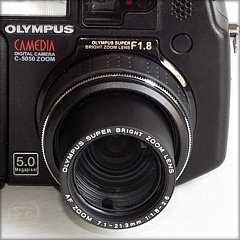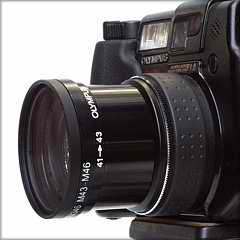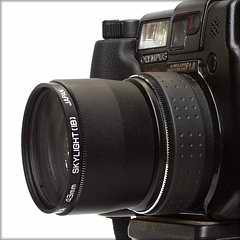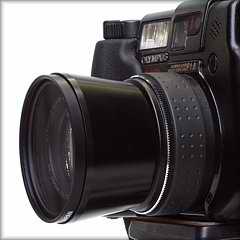
|
Lens Adapters for the Olympus C-5050Z
|

| My other pages related to the Olympus C-5050Z, C-5060WZ, and X-7070WZ |
|
Everything in this article is also applicable to the previous C-series cameras from Olympus: C-40x0Z, C-30x0, and even C-20x0Z (where the 'x' stands for a digit differentiating between similar models), but not to the more recent ones: C-5060WZ and C-7070WZ. Why a lens adapter? The collapsible, motor-driven lens in the '5050 does not have a filter thread. Besides, it is not mechanically secure enough to carry the weight of any auxiliary lens attached to it, even if there were a way to fit one. | |
|
This is why the camera has a thread in the rubberized ring around the lens, visible in this picture. The ring is a part of the camera body, providing a secure mechanical connection. But a connection to what? Here is where the lens adapter ring comes into play. This is a solid metal tube attachable to the said thread, so that it fits around the lens without touching it. Any filters or other lens attachments screw into a thread at front of the adapter so that the lens can fully extend, again, without any mechanical contact. Simple and secure, some other manufacturers (including Canon) are using the same approach. |

|
|
The lens adapter (also known affectionally as the "lens tube") can be used for three purposes:
What you sacrifice using a lens tube is the neat compactness of the camera with it lens retracted: it no longer fits ever-so-snugly under your jacket. The tube adds about 2.5 cm to the camera's depth. The choice if yours, but it is not irreversible. You may decide on a case-by-case basis whether to equip your camera for a given outing, or not. I have used a lens tube on a C-3000Z at the time it was my main (and only) digital camera. With the '5050, I am a little undecided, but after a few months with this camera I find myself using the adapter most of the time. Which one? There are a few lens adapters designed to work with the '5050 (or other Olympus C-series cameras). All of them have a 41 mm rear thread (fitting into the camera body), differing in the front thread size, and, to a lesser degree, in the overall length.
In addition to the above, Kenko makes two adapters: one being an almost exact copy of the CLA-1, and one with the front thread of 52 mm. I haven't tried either of these two, so all I can offer is a link to the THK, their U.S. distributor. (Some dealers mention other Kenko adapters for the '5050, but the THK site does not list them, and I have not seen even the pictures.) CKC Power, an outfit specializing in digital camera add-ons, also have a number of adapters fitting the '5050, which you may check for yourself, especially if you need some other filter thread diameters. In this article I'm focusing on the Olympus and Tiffen models, as being most common and most readily available. As these are the only ones I have used, I will not be able to answer your questions regarding other adapters. | |

| Left to right: the Olympus CLA-1 adapter, the "new" Tiffen, and the "old" Tiffen variety. You can see that the Olympus model is shorter than the others, with implications discussed below. |
|
Let us have a look at all three models mounted on a C-5050Z camera, each with a filter attached to the front. | |

|

|

| |
| Olympus CLA-1 with a 43-46 mm step-up ring, and a 46 mm filter | Tiffen OLYC3000AD with a 43 mm filter | The "old" Tiffen OLYC2000AD with a 49 mm filter |
|
For those who like to know such things: the pictures were taken in my seven-dollar tabletop studio, outdoors, late afternoon, shade, cloudy. Camera used: Olympus E-20, aperture priority with -0.3EV compensation, 1/3 s at F/8, zoom EFL=140 mm, tripod. Does size matter? The Olympus adapter is about three millimeters shorter than the Tiffen ones. This is, I believe, for historical reasons: when it was introduced back in the pioneering days of the C-2020Z, Olympus attachments had various rear threads: from 46 to 55 mm. This is why the adapter was made a little shorter than needed for the fully extended lens — the step-up ring necessary to match the tube's 43 mm front thread to that of the auxiliary lens would provide extra spacing. A side effect of that is that you also need that spacing to use just a filter, or a lens cap, on the CLA-1. If you try to mount a filter directly on the tube, the front of the lens will jam into it when fully extended. One exception is a polarizing filter. These usually have two rings: one with the filter mount, and another one, holding the filter glass on top of that, to allow rotation. This adds some extra space, just enough to accommodate the lens. Therefore usually you will be able to use a 43-mm polarizer directly on the CLA-1. Of course, the CLA-1 could have been just a tad longer, to free us from the step-up ring hassle when filters are used. The designers wanted, however, to keep the spacing between the lens front and the lens attachments as small as possible. This, theoretically at least, assures better optical quality and minimizes the chances of image corner cut-off and/or vignetting. The Tiffens are long enough to accommodate the lens, and filters can be used on them without any extra spacing. This is an advantage, but what about the vignetting and the optical quality loss? As a former physicist I don't take anything for granted. From general considerations, the spacing issue will be more critical, if at all, for wide-angle attachments. Therefore I used the new Olympus WCON-07 wide-angle converter mounted on both tubes (CLA-1 and ALYC3000AD) to shoot pictures of a lens resolution target; then I compared both samples under magnification. The moment of truth: I was not able to see any differences in resolution between both tubes, although I expected to see at least some. There was also no vignetting visible with the use of the longer (Tiffen) adapter. Mind it, this was not a measurement, but a qualitative, although painfully scrutinizing, comparison. Still, if I cannot see a difference in an image magnified on my screen, I will not see it even in a 9x12" print. Therefore my conclusion here is clear: the size difference between 23 and 26 mm does not matter optically, not in any degree I could notice. You may base your choice between the available lens adapter models on other factors. The CLA-1 is just a millimeter short of being able to fit the extended lens; the Tiffen tubes are two millimeters longer than necessary. Settling down on one length of 24 mm would make all this discussion irrelevant, and I don't quite understand why both makers didn't do just that. Choosing the right adapter Now this seems to be simple. With the optical question answered, and having used both the (new and old) Tiffens and the Olympus model, I prefer the (new) Tiffen OLYC3000AD for a number of reasons:
You can buy the Tiffen tube at a number of U.S. dealers, including my favorite source, B&H Photo. The Filter Connection, a small-town business dealing only in filters and rings, has a well-stocked inventory, and is another checked and proven alternative. | |
|
When a lens adapter is used with a filter, it may get in the way of the built-in camera flash, casting some shadow in the bottom-left corner of the frame. The magnitude of the effect and the focal lengths affected by it may vary from adapter to adapter. For my adapter of choice, the Tiffen OLYC300AD, the shadow shows only below the EFL of 40 mm or so. This is illustrated in the accompanying picture. The effect is not strong, and it may go unnoticed with many subjects. To avoid it completely, use an external flash, like the tiny, cute, and well-behaved Olympus FL-20. |

|
|
UV filter on the Tiffen lens adapter, EFL=35mm, internal flash | |
|
What else you may need? If you are going to use any attachment lenses, you will need the right step-up ring(s). For both new Olympus lenses, WCON-08 and TCON-17, this will be the 43-55 size. If you plan on using the tube for lens protection (with a 43 mm UV filter, in case of the Tiffen adapter), remember that your lens cap which came with the camera will be now too small (41 mm instead of 43 mm). You need a 43 mm snap-on lens cap. OK, this is perhaps the longest article on a $15 accessory I have ever seen. Now get out and take some pictures. | |

| My other pages related to the Olympus C-5050Z, C-5060WZ, and X-7070WZ |
|
Camedia® and Olympus® are registered trademarks of Olympus Corporation.
This page is not sponsored or endorsed by Olympus (or anyone else) and presents solely the views of the author. |
| Home: wrotniak.net | Search this site | Change font size |
| Posted 2003/06/12; last updated 2004/06/20 | Copyright © 2003-2004 by J. Andrzej Wrotniak |